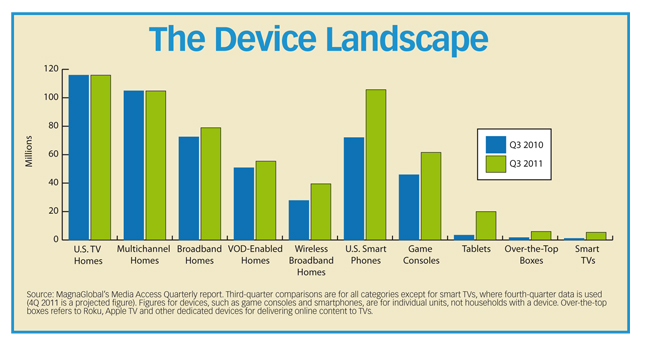'Tis the Season For Connected Devices

Next month’s 2012 International CES isn’t likely to produce any game-changing devices on par with the launch of high-definition, flatpanel television sets or tablets.
In fact, the biggest news is not so much technical improvements as the sheer number of TVs, tablets, smartphones and other devices capable of streaming video over an Internet connection that are moving into homes.
Worldwide, there are already 350 million connected devices that can access video on Google’s YouTube, reports Adam Stewart, industry director of media and entertainment at Google.
By the end of the third quarter, Americans owned 105.7 million smartphones (up 47% from third-quarter 2010), 61.6 million game consoles (a 34% increase), 20 million tablets (a 488% spike) and 6 million over-the-top boxes like Roku (up 253%), according to MagnaGlobal. By the end of the year, MagnaGlobal estimates there will be about 5.4 million smart TVs in the U.S., up 399% from the end of 2010.
How quickly some of those devices will continue to move into homes remains an open question, however, given the ongoing economic woes that turned 2011 into a relatively disappointing year for TV sales. “Some of the more advanced feature sets like backlit LEDs, 3D TV sets and smart TVs have generally not lived up to the expectations manufacturers and retailers had at the start of 2011,” notes Paul Gagnon, director of North America TV research at DisplaySearch, which is predicting set shipments of 42.7 million TVs in 2011, down from 43.9 million in 2010.
Still, holiday sales of electronic devices are already pacing ahead of last year, and products in some hot categories are flying off shelves. Investment bank Piper Jaffray predicts that 13.8 million iPads will be sold worldwide in the fourth quarter.
And those unit sales may underestimate the impact of these devices, which are widely shared among family members. A recent report from eMarketer predicted that the number of Americans using a tablet at least once a month will hit 33.7 million by the end of 2011 and grow to 75 million by 2013, which would translate to about one-quarter of the U.S. population using a tablet.
Other data suggests that consumers are increasingly ready to open their wallets, particularly for larger-size sets and smart TVs in 2012. A recent study by Frank N. Magid Associates found that 40% of consumers were looking to buy a new TV in the next year, with 62% of those shoppers saying an Internet-connected TV was “somewhat” or “very” important among features, notes Maryann Baldwin, VP of Magid Media Futures. “We see consumer interest returning to pre-recession levels,” she says.
Meanwhile, the Digital Entertainment Group is predicting sales of HDTVs 60 inches or larger will grow 50% this year, to 1.3 million units.
So far, the popularity of these new connected devices has had a generally positive impact on the TV industry. Nielsen data going back a number of years has shown steady increases in TV viewing across all age groups, despite growing popularity of online and mobile video.
“We found 52% of online consumers now watch TV shows and movies [online] at least once a month,” Baldwin says, citing data from Magid’s annual late October survey. “But while alternative platform viewing is growing quite rapidly, traditional TV view levels remain stable, and we are also seeing growth in areas like VOD, DVR and DVD usage.”
The attendant explosion of content across these devices has its advantages, but it’s also creating a number of challenges for both operators and programmers.
A recent study from Tribune found that on any given day, around 82,000 unique full-length TV shows and 19,000 movies are available to be viewed online.
Viewing choices have proliferated, but navigational schemes have not simplified. Currently, consumers must laboriously navigate through different apps, screens and devices to find out what might be available on their Netflix, Amazon or multichannel subscriptions.
“There is a real need to bring all content together and make sense of it for the user,” so they can access it via one screen and user interface, notes Alex Vikati, executive director of product strategy and innovation at Tribune Media Services, which offers a number of technical solutions for the problem.
Vikati and others stress that finding a way to unify access to all this content across different consumer devices will be a major issue for consumer electronics manufacturers over the next year.
For example, the rumored launch of a television set from Apple sometime in 2012 could offer users unifi ed access to content on TVs, iPads and iPhones via Apple’s iCloud service.
Others are also putting time and effort toward the problem. Verizon recently began making some of its live channels available on Microsoft’s Xbox 360, and it has integrated with Kinect for Xbox so that Verizon customers can use voice and gesture commands to control their TV viewing.
“Better navigation and finding ways for consumers to move easily through all of those choices on different platforms will be a big issue for the next 12 to 24 months,” notes Ian Olgeirson, lead multichannel analyst at SNL Kagan.
Stewart at Google also argues that the expansion of multiplatform viewing is making mobile devices a more important promotional tool. “Mobile queries for returning broadcast shows in 2011 grew by 92% over the previous year, and returning cable shows saw a 105% increase in mobile queries,” he says.
E-mail comments to gpwin@oregoncoast.com
The smarter way to stay on top of broadcasting and cable industry. Sign up below
